
The diagram below illustrates the appearance of that most mysterious artifact of antiquity, the slide rule.

How could such a strange-looking object be used to perform calculations?
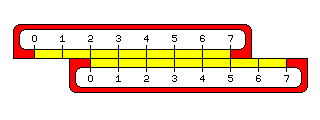
The underlying principle of the slide rule is simple enough. If you take two ordinary rulers, and starting from a position of two units - two inches, two centimeters, whatever you care to imagine - measure a further three units with another ruler, you will obtain a distance of five units - which the first ruler will indicate.
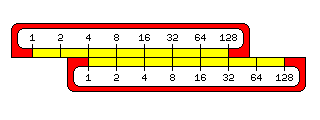
Multiplication behaves like addition. If you multiply 2 by itself over and over, you will get the powers of two, and 8 times 32 is the same as 16 times 16, just as 3 plus 5 is the same as 4 plus 4.
If, instead, you multiplied a very small number by itself, you could find at least an approximate place to put every number in order to multiply by adding. There are, however, easier ways to calculate logarithms.
The logarithm function is the inverse of the power function. Thus, 4 is 2 to the second power, 8 is 2 to the third power, 16 is 2 to the fourth power, and 2 is the logarithm of 4 to the base 2, 3 is the logarithm of 8 to the base 2, and 4 is the logarithm of 16 to the base 2.
Common logarithms are logarithms to the base 10. This makes them convenient for doing arithmetic, because the integer part of a common logarithm indicates where to put the decimal point, and the fractional part is the same for the logarithm of 326, 32.6, or 3.26, so that tables need only contain the fractional part of a common logarithm.
Natural logarithms are logarithms to the base e, where e is 2.71828..., a fundamental constant like pi. These logarithms are more fundamental when working with calculus, but aren't as useful for everyday calculations. But while common logarithms are the basis of the slide rule, natural logarithms will turn up when we examine more advanced scales.
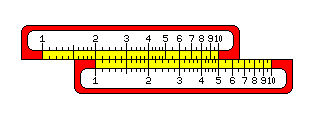
Here we see two slide rule scales set up to multiply the numbers on the bottom scale by 2. Thus, 1 was placed under the 2; therefore, 2 is under the 4, 3 is under the 6, 4 is under the 8, and 5 is under the 10.
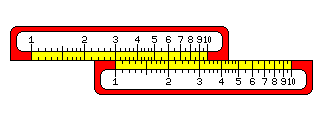
This works just as well for other numbers; here, the 1 is placed under the 3, and so the 2 is under the 6, and the 3 is under the 9.

But what happens to the other numbers when they're multiplied by 3? One way to find out would be to add a second scale to the end of the top scale. This way, we see the following:
The small tick marks between "10" and "20" divide the area between them into ten parts, so each small tick mark in that area stands for 1. Thus, we can see that the 4 stands under 10 and two tick marks, or 12.
Similarly, 5 stands under 15, and 6 stands under 18.
From 20 to 50, there are only five tick marks between each number and the number that is 10 greater. So each tick mark stands for 2.
Thus, we see that 3 times 7 is 21, since the 7 is under a point about halfway between the 20 and the first tick mark following it.
On the other hand, that 3 times 8 is 24 is easy to see, as that falls under the second tick mark after 20.
And, since 3 times 9 is 27, again we see that the 9 is between the tick marks that represent 26 and 28.
Finally, the 10 falls under the 30.
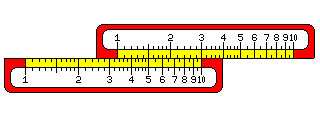
Noting how the scales on a slide rule simply repeat themselves, one can put the 10 instead of the 1 under the number by which one wishes to multiply to see the other possible products. This lets one use the C and D scales, instead of the A and B scales, which are on a smaller scale, to multiply, giving more accuracy.
Having seen how to do basic multiplication on a slide rule, we can now understand the basic scales on a slide rule, as shown in the first image above.
If you multiply a number by itself, the result will be twice the distance from the index - the 1 mark - as the original number was. So if you have two slide rule scales, one twice as big as the other, if their indexes are aligned, each number on the scale that is twice as big corresponds to the location of its square on the smaller scale.
Thus, the A and B scales, at half the side, with the scales repeated twice, aren't just for beginning slide rule users. Rather, they let people work with squares and square roots.
Similarly, the K scale is at one third of the scale of the C and D scales, and so it is used for cubes and cube roots.
The CI scale is the same as the C scale, except it runs backwards. Since division is the opposite of multiplication, this scale can be used to find reciprocals.
Of course, it's obvious from the way that multiplication is performed on a slide rule that you can perform division without the need for such a scale; going from 3 to 1 measures out the same distance backwards as going from 1 to 3 does forwards. So if you place the 1 on one scale under the 3 on the other, not only can you see 3 times any number on the bottom scale on the top scale, but you can also see any number on the top scale divided by 3 on the bottom scale.
The L scale is a uniform linear scale, and is used to read off the fractional portion (or mantissa) of the common logarithm of numbers on the C scale.
Note that the illustration of a simple slide rule at the top of the page corresponds to the distribution of tick marks on a 5-inch slide rule (actually, one with a 12.5 cm scale), not the usual 10-inch (25 cm) slide rule. Despite this, and despite the use of 600 pixels to represent the scale width, the positions of the tick marks are noticeably uneven. Because slide rules have scales which gradually vary in size, they are very difficult to depict well in discrete pixels.
A BASIC program was used to draw a picture in the .xbm file format, containing the plain scales with ticks of varying size and spacing but no numerals, which I then viewed with a web browser, and got into a paint program by using the clipboard.
A width of 600 pixels was chosen to allow the L scale, at least, to appear uniform, and to allow the two repeated occurences of the scale on the A and B scales, and the three occurences on the K scale, to be identical.
For the other diagrams on this page, one copy of the scale from the K scale was used to represent the C and D scales, and a slightly smaller scale was used, so that the distance between 1 and 2 was exactly 53 pixels, and the distance between 1 and 10 was 176 pixels. (The same program drew the log-log scale used in the diagrams above; instead of replying 600 to the prompt for the width of the slide rule, I replied 528, which is three times 176, to obtain the raw materials for those diagrams.) As noted on my page about the musical scale, this particular division allowed ratios involving 2, 3, and 5 to be well-represented. Thus, while the irregularity in the spacing of the ticks could not be eliminated, at least it repeated at convenient intervals so that the rules could be shown sliding against each other in diagrams which gave a reasonable appearance without having to cheat by shifting some of the ticks by hand from their calculated positions. (I had tried other possibilities, involving approximations only to log(2), but because that is 0.3010299... rational approximations to it, while good, are widely spaced, or involving computer searches for ratios that minimize error over all the tick marks, but they were not as successful.)
Incidentally, some older slide rules have an appearance like this:
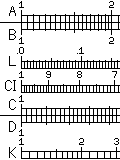
Although this makes them more difficult to read, by isolating the eye from the varying heights of the ticks, this arrangement may have been presumed to have the effect of reducing bias in estimating positions between tick marks.
The modern type of slide rule scale started to appear around the year 1910, but some European slide rule makers, notably Unique in Britain and Nestler in Germany, retained the old style of scale for decades thereafter.
My explanatory diagrams above don't quite use this arrangement; instead, I was trying to dramatize the difference between tick marks further to make the diagrams easier to follow; thus, only major tick marks close a box in what I have drawn, quite the opposite of the older slide rule design.